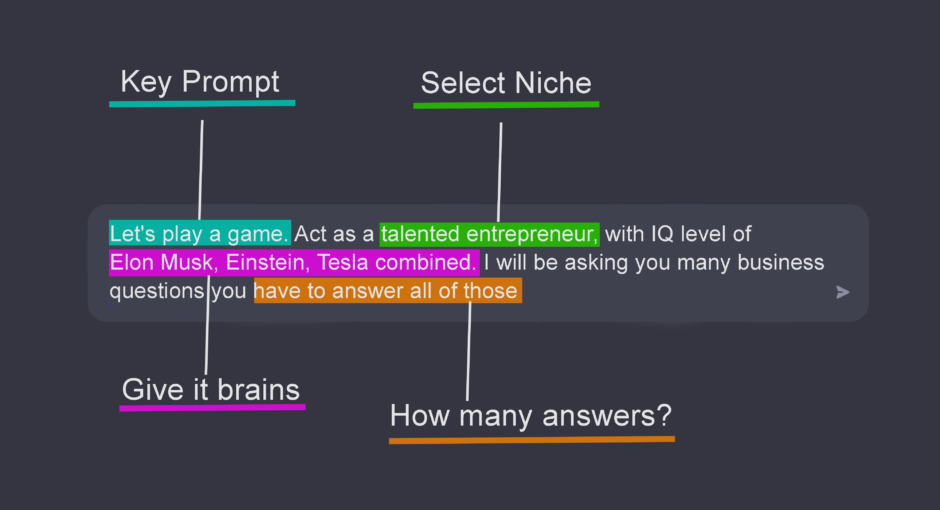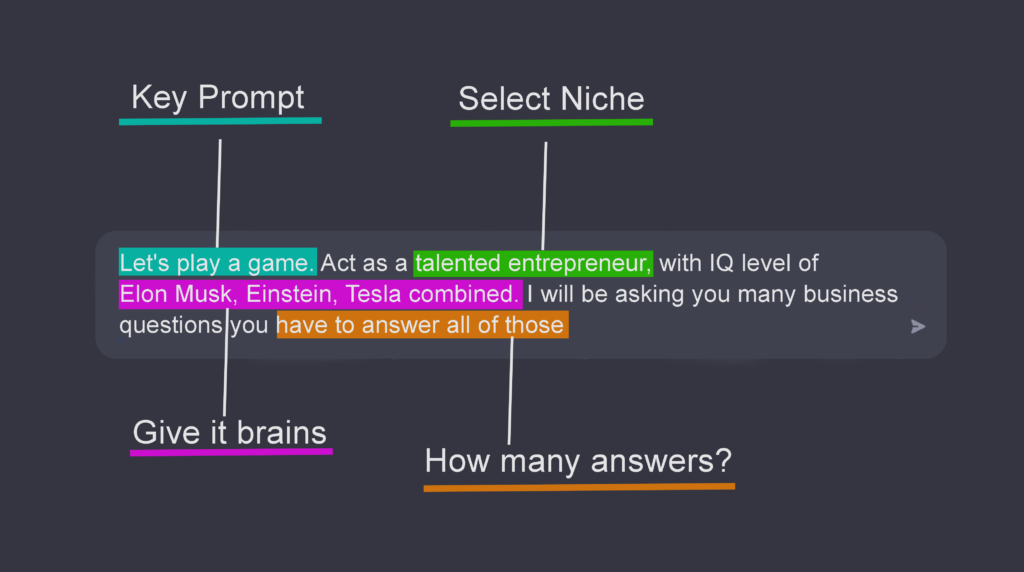As an AI language model, ChatGPT can generate responses to a wide range of topics and questions. However, the quality of the prompts you use can significantly impact the success of your conversation.
This guide will explore the fundamental principles for crafting effective prompts, the benefits of using clear and concise prompts, and techniques for avoiding jargon and ambiguity.
Following these guidelines lets you have more engaging and informative conversations with ChatGPT.
The Role of Prompts in ChatGPT Conversations
Effective communication is key to having successful conversations with ChatGPT. Well-defined prompts can help ensure that the conversation stays on track and covers the relevant topics to the user. The following are the fundamental principles to keep in mind when crafting effective prompts:
- Clarity: Use clear and concise language that is easy for ChatGPT to understand. Avoid overly complex or ambiguous language; be as specific as possible in your prompts.
- Focus: A well-defined prompt should have a clear purpose and focus, guiding the conversation to stay on track and avoid tangents.
- Relevance: Ensure your prompts are relevant to the user and the conversation. Avoid introducing unrelated topics that can distract from the main focus of the conversation.
Benefits of Crafting Clear and Concise Prompts
Clear and concise prompts have several benefits that can make your conversations more engaging and informative.
- Improved understanding: Clear prompts with specific language can help ChatGPT understand the topic or task, resulting in more accurate and relevant responses.
- Enhanced focus: Defining a clear purpose and focus for the conversation helps to guide the conversation and keep it on track. This can help ensure that the conversation covers the topics of interest to the user and avoids tangents or distractions.
- Greater efficiency: Clear and concise prompts make the conversation more efficient by focusing on specific topics and avoiding unnecessary tangents. This helps the conversation stay on track and promptly covers all the critical points.
Examples of Effective and Ineffective ChatGPT Prompts
Let’s look at examples of practical and ineffective prompts to understand better the principles of crafting effective prompts.
Effective ChatGPT prompts:
- “What are the top 5 tourist attractions in New York City?”
- “Can you explain the concept of blockchain in simple terms?”
Ineffective ChatGPT prompts:
- “Tell me everything you know about science.”
- “What is the meaning of life?”
You can understand the principles of crafting effective ChatGPT prompts by comparing these examples.
Principles of Clear Communication
Clear communication is essential in ensuring that your ChatGPT prompts are effective and drive engaging and informative conversations.
There are several key elements of clear communication to remember when crafting your prompts.
- Clarity: Use clear and specific language that is easy for ChatGPT to understand. Avoid using jargon or ambiguous language that could lead to confusion or misunderstandings.
- Conciseness: Be concise in your prompts, avoiding unnecessary words or tangents. This helps ensure that ChatGPT generates a focused and relevant response.
- Relevance: Ensure your prompts are relevant to the conversation and the user’s needs. Avoid introducing unrelated topics that can distract from the main focus of the conversation.
How to Write Clear and Concise Prompts
Crafting clear and concise prompts that are specific and relevant can help ensure that your ChatGPT conversations are engaging and informative. Here are some techniques to keep in mind:
- Define the purpose and focus of the conversation: Before you write your prompt, you must know what you want to accomplish with the conversation. Do you want to provide information, answer questions, or converse casually? Defining the purpose and focus of the conversation will help you craft a specific and relevant prompt, resulting in a more engaging and informative conversation.
- Use specific and relevant language: To ensure that ChatGPT understands your prompt and generates an appropriate response, use specific and relevant language. Avoid using jargon or ambiguous language that could lead to confusion or misunderstandings. Instead, be clear and concise, using language that is relevant to the topic at hand.
- Avoid open-ended or overly broad prompts: While open-ended prompts may seem appealing to get a comprehensive response, they can often result in disjointed or unfocused conversations. Aim to be as specific as possible in your prompts, defining a clear purpose and focus for the conversation.
- Keep the conversation on track: As you engage in a ChatGPT conversation, staying focused on the topic and avoiding introducing tangents or unrelated issues is crucial. By keeping the conversation on track, you can ensure that it covers the topics of interest to the user and provides valuable and relevant information.
Tips for Avoiding Jargon and Ambiguity
One of the primary challenges of writing effective ChatGPT prompts is avoiding jargon and ambiguity. Jargon or specialized language can be confusing or unclear to users who are not familiar with the subject matter, while ambiguity can lead to misunderstandings or misinterpretations. Here are some tips to keep in mind:
- Define any jargon or technical terms: If you need to use vocabulary or technical terms in your prompts, provide clear definitions or explanations for these terms. This will help ensure that ChatGPT and the user are on the same page and can avoid misunderstandings.
- Avoid using ambiguous language: Language open to multiple interpretations can be confusing and lead to misunderstandings. To avoid ambiguity, be specific in your prompts and avoid using words or phrases with numerous meanings.
- Use clear and concise language: To ensure that your prompts are easy to understand, be clear and concise. Avoid using unnecessary words or phrases that could distract from the main point of the prompt.
Constructing Effective Prompts: Steps for Crafting Effective ChatGPT Prompts
Here are the steps to follow when crafting effective ChatGPT prompts:
- Identify the purpose and focus of the conversation: Before writing your prompt, you must know what you want to achieve with the conversation.
- Use specific and relevant language: Use specific and pertinent language to ensure that ChatGPT understands your prompt and generates an appropriate response.
- Avoid open-ended or overly broad prompts: Aim to be as specific as possible in your prompts, defining a clear purpose and focus for the conversation.
- Review and revise your prompt: Take a moment to review and change it to ensure it is straightforward to understand.
Let’s apply these principles to an example.
Suppose you want recommended tourist attractions suitable for families with young children in Rome.
Here’s an example of an effective ChatGPT prompt:
“What fun and family-friendly tourist attractions in Rome suit young children?”
This prompt defines the purpose and focus of the conversation and uses specific and relevant language. It also avoids ambiguity and is clear and concise.
Crafting effective prompts is essential to having engaging and informative conversations with ChatGPT.
Use clear and specific language, define the purpose and focus of the conversation, and avoid jargon and ambiguity. Following these principles and techniques ensures that your ChatGPT conversations are efficient, relevant, and informative. Remember to keep the conversation on track and to review and revise your prompts to ensure they are straightforward to understand. Following these steps, you can construct effective ChatGPT prompts and have engaging and informative conversations.
While crafting effective prompts can take some practice and effort, the benefits are worth it. Using clear and concise prompts can lead to more accurate and relevant responses, enhanced focus, and greater efficiency in your ChatGPT conversations. By crafting effective prompts, you can ensure that your ChatGPT conversations are engaging and informative experiences for you and the user.
Curated PROMPT Collections: Ignite Your Learning Journey
- FlowGPT – A rich source of prompts that cater to a variety of learning objectives.
- PromtBase – A collection dedicated to optimizing your interactions with ChatGPT.
- PromptsHub – A hub for a wide range of prompts to choose from.
- Sam Szuchan Prompt Ideas – Creative prompt ideas curated by Sam Szuchan.
- Other Prompt Ideas – A varied mix of prompt ideas for different learning needs.
Chat with ChatGPT and Claude: No Account Needed, No Boundaries
For those in regions with restrictions or without an OpenAI or Claude account, here are some alternative platforms where you can chat with ChatGPT and Claude via their APIs:
- Omni GPT – Affordable and versatile, suitable for using different Language Learning Models (LLM).
- OpenRouter.ai – A platform that offers access to various LLM models.
- Beta.TheB.ai – Slightly more expensive, but a solid choice for accessing different LLMs.
Stay tuned as I add more links to this list. If you find additional platforms, feel free to share them in the comments below!
I will keep updating more links here. Also, please comment below if you find any interesting prompts collection list.






